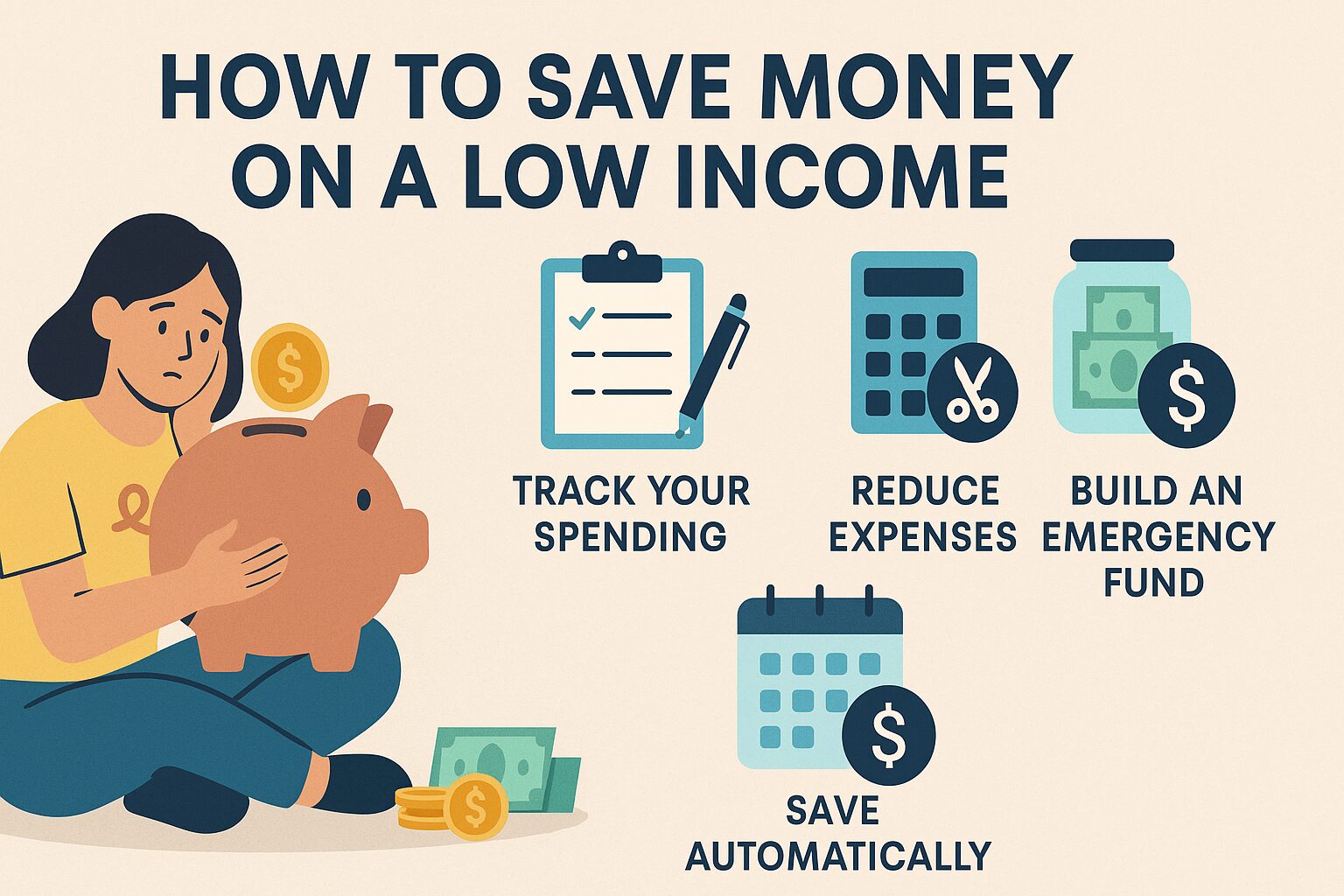Discover how to save money on a low income with 17 smart, practical tips. Build savings, reduce expenses, and take control of your finances—starting today!
How to Save Money on a Low Income: Smart Strategies That Actually Work
Living on a low income doesn’t mean you can’t save money. It just requires a different approach — one that is intentional, creative, and focused on your long-term goals. Whether you’re a
How to Save Money on a Low Income:
student, working a minimum-wage job, or supporting a family on a tight budget, this guide will teach you how to save money on a low income without feeling deprived.
In this in-depth article, we’ll explore practical tips, mindset shifts, and tools that will help you build savings even when your income feels limited. Let’s get started.
Why Saving on a Low Income Is Challenging (But Possible)
Saving money when you earn a low income can feel like an impossible task. Rising rent, food prices, utility bills, and
unexpected expenses often consume most of the paycheck. However, the key isn’t necessarily earning more (though that helps) — it’s managing what you already have.
Saving is not just about the amount — it’s about building the habit of saving, no matter how small.
1. Track Every Dollar You Spend
The first step to saving money on a low income is to know where your money goes. Most people don’t realize how small purchases add up. Use a notebook, app (like Mint or YNAB), or a spreadsheet to track:Best Budgeting Apps for USA to Manage Money in 2025
Rent or mortgage
Groceries
Utilities
Subscriptions
Eating out
Gas and transportation
Entertainment
Tracking helps you identify spending patterns and cut out waste.
2. Create a Realistic Monthly Budget
A budget is your financial roadmap. It’s especially crucial for low-income earners because every dollar needs a purpose. Use the 50/30/20 rule as a guideline:
50% Needs (rent, food, utilities)
30% Wants (entertainment, subscriptions)
20% Savings & Debt Repayment
If 20% is too much, start with 5% or 10%. The point is to start somewhere.
Focus Keyword Tip:
When planning a budget, always think about how to save money on a low income by setting limits in each category.
3. Cut Non-Essential Expenses
This is where real savings begin. Review your spending and look for areas to trim, such as:
Cancel unused subscriptions (Netflix, gym, magazines)
Cook at home instead of dining out
Skip coffee shops – brew at home
Shop second-hand or discount stores
Limit online shopping and impulse buying
Frugality isn’t about depriving yourself — it’s about aligning spending with your priorities.
4. Use Cash Envelopes for Control
The cash envelope system is a budgeting method where you use physical cash for spending categories (like groceries or gas). Once the envelope is empty, you stop spending in that category.
This system can prevent overspending and create a tangible connection to your money — especially helpful when learning how to save money on a low income.
5. Build an Emergency Fund – Even $5 at a Time
An emergency fund prevents you from going into debt when unexpected expenses hit (car repairs, medical bills, etc.). You don’t need to start big — even saving $5/week can add up.
Open a high-yield savings account (like from Ally, Capital One 360, or Discover Bank) and set up automatic transfers — small, consistent savings matter.
6. Take Advantage of Government Assistance Programs
If you live in the U.S., several programs are designed to support low-income individuals and families. These include:
SNAP (food stamps)
Medicaid (health insurance)
LIHEAP (help with energy bills)
Section 8 housing
Free or low-cost school lunches
WIC (for women, infants, and children)
Don’t feel ashamed to use them — they exist to support you while you work toward stability.
7. Lower Your Utility Bills
Utilities can eat up your income if you’re not careful. Here’s how to reduce them:
Use energy-efficient lightbulbs
Unplug electronics when not in use
Turn off lights in empty rooms
Wash clothes in cold water
Adjust your thermostat seasonally
Many utility companies also offer budget billing or assistance programs.
8. Eliminate or Reduce High-Interest Debt
Debt can feel like a trap, especially when interest charges build faster than you can pay. Here’s what to do: https://bettermoneyhabits.bankofamerica.com/en/saving-budgeting/ways-to-save-money
How to Save Money on a Low Income:
List all your debts with interest rates
Pay minimums on all, but put extra toward the highest interest one (avalanche method)
Consider debt consolidation or credit counseling
Avoid payday loans — they are dangerous
When figuring out how to save money on a low income, removing high-interest debt is a game changer.
9. Shop Smarter for Groceries
Food is a major expense, but you can save without sacrificing nutrition:
Shop with a list and don’t shop hungry
Buy in bulk when possible
Choose generic over brand names
Use apps like Ibotta, Fetch, and Rakuten for cashback
Meal plan and use leftovers
You’d be surprised how much you can save by shopping strategically.
10. Get Creative with Side Income
Even if your main income is low, there are small ways to bring in extra cash:
Freelancing (writing, design, editing)
Babysitting or pet sitting
Selling crafts, clothes, or unused items online
Tutoring or giving lessons
Participating in surveys or cashback apps
Extra income can go directly into savings or paying off debt — a key part of how to save money on a low income in the U.S.
11. Take Advantage of Free Community Resources
Look into local resources that can replace things you’d otherwise pay for:
Free events and workshops
Public libraries (books, movies, internet)
Local food pantries or community fridges
Free fitness programs or parks
These can significantly reduce your monthly spending while still enjoying life.
12. Practice Delayed Gratification
Learning to say “not now” is powerful. Before making a purchase, ask:
Do I need this today?
Can I find it cheaper?
Can I wait a week and see if I still want it?
Delayed gratification helps you focus on long-term financial goals rather than instant pleasure.How to Save Money on a Low Income
13. Automate Your Savings
Set up automatic transfers from checking to savings — even $10 a paycheck counts. If you never see the money, you won’t miss it.
Some apps like Acorns, Chime, or Digit can help automate your savings with round-ups or small daily deposits.
14. Reevaluate Housing and Transportation Costs
These two areas usually take the biggest portion of your income. Consider:
Getting a roommate to split rent
Moving to a cheaper neighborhood
Using public transit or biking
Trading in your car for a more affordable option
Even saving $100/month in these categories makes a big difference over time.
15. Set Small, Achievable Financial Goals
Big goals can be overwhelming. Instead, try:
Save $100 in 30 days
Pay off one small debt in 2 months
Skip takeout for 2 weeks
Small wins build momentum, boost confidence, and help you feel in control.
16. Use Tax Refunds or Bonuses Wisely
If you get a tax refund or work bonus, don’t splurge. Instead:How to Save Money on a Low Income
Add to your emergency fund
Pay down debt
Buy something useful that saves money long term (like a reusable water bottle or rice cooker)
Treat this money as a tool, not a toy.
17. Educate Yourself About Money
Financial literacy can dramatically change your future. Free ways to learn:
Podcasts: The Budgetnista, Money Girl, Afford Anything
Books: The Total Money Makeover, Your Money or Your Life
YouTube channels: Graham Stephan, The Financial Diet
Blogs: NerdWallet, Clark.com, Mr. Money Mustache
The more you know, the more confident and in control you’ll feel.
FAQs About How to Save Money on a Low Income
Q1: Can I really save money if I live paycheck to paycheck?
Yes! Even small amounts like $5/week build the habit. Start with micro-saving and automate it.
Q2: What’s the best budgeting method for low-income earners?
Try zero-based budgeting or the envelope system. Both help allocate every dollar wisely.
Q3: How do I save if I have kids and expenses are high?
Look into child tax credits, SNAP, WIC, and free childcare programs. Also, involve kids in frugal living.
Q4: Should I focus on saving or paying off debt first?
Do both, but prioritize high-interest debt. Save a small emergency fund first, then aggressively pay debt.
Q5: How do I stay motivated to save?
Set visual goals (savings tracker jar), celebrate small wins, and remind yourself why you started.
Final Thoughts: You Can Save Money on a Low Income — One Step at a Time
Learning how to save money on a low income isn’t about being perfect — it’s about being consistent, intentional, and resourceful. Start with one or two small changes and build from there. Over time, those small actions add up to big financial wins.
Remember, it’s not how much you make — it’s how well you manage what you have.

About Us – जानवी कंप्यूटर कोर्स में आपका स्वागत है
नमस्कार दोस्तों,
janavicomputercourse.com पर आपका हार्दिक स्वागत है!
इस वेबसाइट का उद्देश्य घर बैठे कंप्यूटर शिक्षा, सरकारी योजनाओं, टेक्नोलॉजी टिप्स, और से जुड़ी जानकारी को हिंदी भाषा में सरल और सहज रूप में आप तक पहुंचना है l
हम कौन हैं?
मेरा नाम जानवी सरोज है। मैं वर्ष 2021 से कंप्यूटर और तकनीकी क्षेत्र से जुड़ी हुई हूँ। मैंने इस वेबसाइट की शुरुआत इस विश्वास के साथ की थी कि हर व्यक्ति को तकनीकी ज्ञान तक पहुंच होनी चाहिए — वह भी बिल्कुल मुफ्त में और अपने ही भाषा में।
हमारी वेबसाइट पर क्या मिलेगा?
janavicomputercourse.com पर आपको निम्न विषयों पर Step by Step जानकारी हिंदी में मिलेगी:
Computer Course Based on Latest CCC Syllabus
Introduction to Computers (हिंदी और इंग्लिश माध्यम दोनों के लिए
Basic to Advanced कंप्यूटर कोर्स की जानकारी
सरकारी योजनाएं एवं रिपोर्ट्स
1,शिक्षा और करियर
2.कंप्यूटर कोर्स
3.सरकारी योजना
4.सरकारी नौकरी
5.हेल्थ और फिटनेस
6.Finance (English
प्रधानमंत्री योजनाएं (जैसे जन धन योजना)
हमारा उद्देश्य
हमारा मुख्य लक्ष्य है –
“हर घर तक कंप्यूटर और टेक्नोलॉजी की पहुंच बनाना, वो भी सरल हिंदी में।”
हमारा मानना है कि डिजिटल भारत तभी सफल होगा जब हर व्यक्ति कंप्यूटर और इंटरनेट की बुनियादी जानकारी रखेगा। इसी दिशा में हम प्रयासरत हैं।
आपका सहयोग जरूरी है
आपसे निवेदन है कि वेबसाइट पर मौजूद ब्लॉग पोस्ट को अधिक से अधिक शेयर करें, ताकि ज्यादा लोग इसका लाभ उठा सकें।
आपकी प्रतिक्रिया और सुझाव हमारे लिए बेहद मूल्यवान हैं — इससे हमें अपनी सामग्री और सेवा को और बेहतर करने का अवसर मिलता है।
संपर्क करें
यदि आपके पास कोई प्रश्न, सुझाव, या कंप्यूटर कोर्स से संबंधित जानकारी है, तो आप हमसे संपर्क कर सकते हैं:
Email: devir848630@gmail.com
या हमारी वेबसाइट के [Contact Us Page] पर जाएं।
ध्यान दें: हम निरंतर प्रयासरत हैं कि आपको सटीक, अपडेटेड और विश्वसनीय जानकारी प्रदान करें।
धन्यवाद!
– जानवी सरोज और टीम











